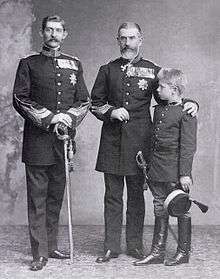Carol I of Romania
| Carol I | |||||
|---|---|---|---|---|---|
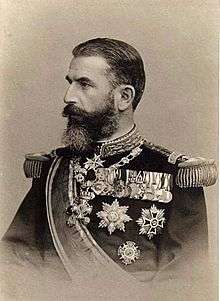 | |||||
| King of Romania | |||||
| Reign | 15 March 1881 – 10 October 1914 | ||||
| Coronation | 10 May 1881 | ||||
| Successor | Ferdinand I | ||||
| Domnitor of Romania | |||||
| Reign | 20 April 1866 – 15 March 1881 | ||||
| Predecessor | Alexandru Ioan Cuza | ||||
| Born |
20 April 1839 Sigmaringen, Germany | ||||
| Died |
10 October 1914 (aged 75) Sinaia, Romania | ||||
| Burial | Curtea de Argeș, Romania | ||||
| Spouse | Elisabeth of Wied | ||||
| Issue | Princess Maria | ||||
| |||||
| House | Hohenzollern-Sigmaringen | ||||
| Father | Prince Karl Anton of Hohenzollern-Sigmaringen | ||||
| Mother | Josephine of Baden | ||||
| Religion | Roman Catholic | ||||
| Signature |
 | ||||
Carol I (20 April 1839 – 27 September (O.S.) / 10 October (N.S.) 1914), born Prince Karl of Hohenzollern-Sigmaringen, was the monarch of Romania from 1866 to 1914. He was elected Ruling Prince (Domnitor) of the Romanian United Principalities on 20 April 1866 after the overthrow of Alexandru Ioan Cuza by a palace coup d'état. In May 1877, he proclaimed Romania an independent and sovereign nation. The defeat of the Ottoman Empire (1878) in the Russo-Turkish War secured Romanian independence, and he was proclaimed King of Romania on 26 March [O.S. 14 March] 1881. He was the first ruler of the Hohenzollern-Sigmaringen dynasty, which ruled the country until the proclamation of a republic in 1947.
During his reign, Carol I personally led Romanian troops during the Russo-Turkish War and assumed command of the Russo/Romanian army during the siege of Plevna. The country achieved internationally recognized independence via the Treaty of Berlin, 1878 and acquired Southern Dobruja from Bulgaria in 1913. Domestic political life was organized around the rival Liberal and Conservative parties. During Carol's reign Romania's industry and infrastructure improved a lot, but the country still had an agrarian economy and the situation of the peasantry failed to improve.
He married Princess Elisabeth of Wied in Neuwied on 15 November 1869. They only had one daughter, Maria, who died at the age of three.
Carol never produced a male heir, leaving his elder brother Leopold next in line to the throne. In October 1880 Leopold renounced his right of succession in favour of his son William, who in turn surrendered his claim six years later in favour of his younger brother, the future king Ferdinand.
Early life
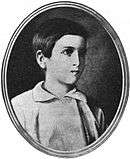

Prince Karl Eitel Friedrich Zephyrinus Ludwig of Hohenzollern-Sigmaringen was born in Sigmaringen, the second son of Prince Karl Anton of Hohenzollern-Sigmaringen and his wife, Princess Josephine of Baden. After finishing his elementary studies, Karl entered the Cadet School in Münster. In 1857 he was attending the courses of the Artillery School in Berlin. Up to 1866, when he accepted the crown of Romania, he was a Prussian officer. He took part in the Second Schleswig War, including the assault of the Fredericia citadel and Dybbøl, an experience which would be very useful to him later in the Russo-Turkish war.
Although he was quite frail and not very tall, prince Karl was reported to be the perfect soldier, healthy and disciplined, and also a very good politician with liberal ideas. He was familiar with several European languages. His family was closely related to the Bonaparte family (one of his grandmothers was a Beauharnais, Joséphine's niece-in-law, and the other a Murat, Joachim's niece Marie Antoinette Murat), and they enjoyed very good relations with Napoleon III of France.
En route to Romania
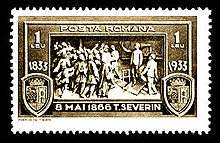
The former Domnitor of united Romania, Alexandru Ioan Cuza, had been expelled from the country by the leading noblemen, leaving Romania in political chaos. Cuza's double election, both in Wallachia and in Moldavia, had been the basis on which the Romanian Principalities' unification was recognized by the European powers. With him gone, the country was in danger of disintegration.
As Romanian politicians searched for a successor, Napoleon suggested Karl. Napoleon's recommendation weighed heavily with Romanian politicians of the time, since Romania was strongly influenced by French culture. Another factor was Karl's blood relation to the ruling Prussian family. Ion Brătianu was the Romanian politician sent to negotiate with Karl and his family the possibility of installing him on the Romanian throne.
Due to the political conflict between Prussia and the Austrian Empire, Karl travelled incognito by railroad from Düsseldorf to Baziaș, through Switzerland. He received there a Swiss passport from a Swiss public clerk, friend of his family, under the name of Karl Hettingen. From Baziaș he travelled by boat to Turnu Severin, since there was no railroad to Romania. As he crossed the border onto Romanian soil, he was met by Brătianu, who bowed before him and asked Karl to join him in his carriage. He was elected Domnitor ("Reigning Prince") on 20 April.
On 10 May 1866 (22 May 1866 N.S.), Karl entered the capital Bucharest. The news of his arrival had been transmitted by telegraph and he was welcomed by a huge crowd eager to see the new ruler. In Băneasa he was given the keys to the capital city. Eventually it was a rainy day after a long period of drought, apparently a very favorable sign. As he was crowned, Karl swore this oath: "I swear to guard the laws of Romania, to maintain the rights of its People and the integrity of its territory." He spoke in French, as he did not speak Romanian. However, he endeared himself to his adopted country by adopting the Romanian spelling of his name, Carol.
The Constitution

Immediately after arriving in the country, the Romanian parliament adopted, on 29 June 1866, the 1866 Constitution of Romania, one of the most modern constitutions in that time. It guaranteed private propriety, freedom of speech, total freedom of the press and established separation of powers. This constitution allowed the development and modernization of the Romanian state. In a daring move, the Constitution chose to ignore the nominal suzerainty of the Ottoman Empire, which paved the way towards de jure independence.
Article 82 made the throne a hereditary office of Carol's descendants "on the male line through the right of first-born, perpetually excluding women and their descendants." It also required that Carol's descendants be "raised in the Eastern Orthodox Religion." It, like all but one of its successors, enshrined the principle that the prince reigned, but did not rule. Although Carol was vested with executive power, he was not politically responsible for exercising it. His acts were only valid if they were countersigned by a minister, who then became responsible for the act in question. Nevertheless, he commanded great moral authority as a symbol of the nation and its unity.
War of independence (1877-1878)
In 1877, Carol proclaimed Romania independent, ending the legal fiction of Ottoman suzerainty that had existed since 1861. From 1878, Carol held the title of Royal Highness (Alteță Regală). On 15 March 1881, the constitution was amended to proclaim Romania a kingdom. Carol became the first king, while the heir-apparent or heir-presumptive would be called Prince Royal. On 10 May, Carol was crowned king. The 1866 Constitution was retained, with the word "prince" replaced by the word "king".
King of Romania
King Carol was a cold man who was always focused on the prestige of the dynasty he had founded. His wife, Elizabeth, claimed he 'wore the crown in his sleep'. He was very meticulous and he tried to impose his style upon everyone that surrounded him. Though he was devoted to his job as Romania's ruler, he never forgot his German roots. In 48 years of rule—the longest in Romanian history—he helped Romania gain its independence, raised its prestige, helped redress its economy and established a dynasty. In the Carpathian mountains, he built Peleș Castle in German style, which is considered one of Europe's most beautiful castles and is still one of Romania's most visited landmarks. After the Russo-Turkish war, Romania gained Northern Dobruja and Carol ordered Romanian engineer Anghel Saligny (a student of Gustave Eiffel) to build the first bridge over the Danube, between Fetești and Cernavodă, linking the newly acquired province to the rest of the country. The bridge was, at that time, the largest in Europe and is still used today.
The end of the reign
The long rule of Carol helped the quick development of the Romanian state. Towards the end of his reign and the start of World War I, Carol wanted to enter the war on the side of the Central Powers; however, Romanian public opinion was overwhelmingly Francophile and sided with the Triple Entente. Carol had signed a secret treaty in 1883 which had linked Romania with the Triple Alliance. Although the treaty was to be activated only if Russia attacked one of the signatories, Carol was convinced that the honourable thing to do was to enter the war supporting the German Empire and his cousin, Emperor William II.[1][2]
On 3 August [O.S. 21 July] 1914, an emergency meeting was held with the Crown Council, where Carol told them about the secret treaty and shared his opinion with them. However, most of the Crown Council members strongly disagreed, opting for neutrality. King Carol died on 10 October [O.S. 27 September] 1914. The new king, Ferdinand (under the influence of his wife, Marie of Edinburgh, a British princess), was more willing to listen to public opinion.
Life and family
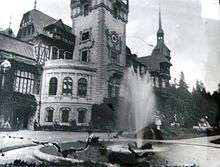
When he was elected prince of Romania, Carol was unmarried. In 1869, the prince started a trip around Europe and mainly Germany, to find a bride. During this trip he met and married Princess Elizabeth of Wied at Neuwied on 15 November 1869. Their marriage was strange, with Carol being a cold and calculating man while Elizabeth was a notorious dreamer. They had one child, Princess Maria, born in 1870, who died 9 April (N.S.) 1874. She had no prospect of inheriting her father's throne; as mentioned above, the Constitution limited succession to the male line. This led to the further estrangement of the royal couple, Elizabeth never completely recovering from the trauma of losing her only child.
After the proclamation of the Kingdom (1881), the succession was a very important matter of state. Since Carol's brother, Leopold (in 1880), and his oldest son, William (in 1886), declined their rights, the second son of Leopold, Ferdinand, was named prince of Romania and heir-presumptive to the throne, in 1886.
Towards the end of Carol's life, though, Carol and Elizabeth finally found a way to understand each other and were reported to have become good friends.
Titles, styles and honours
| Styles of King Carol I of Romania | |
|---|---|
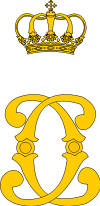 | |
| Reference style | His Majesty |
| Spoken style | Your Majesty |
| Alternative style | Sir |
Titles
- 20 April 1839 – 20 April 1866: His Serene Highness Prince Karl of Hohenzollern-Sigmaringen
- 20 April 1866 – 15 March 1881: His Royal Highness The Prince of The United Principalities of Romania
- 15 March 1881 – 10 October 1914: His Majesty The King of Romania
National honours

- Sovereign Knight Grand Cross with Collar of the Order of the Star of Romania
- Sovereign Knight of the Order of Carol I
- Sovereign Knight Grand Cross of the Order of the Crown of Romania
- Sovereign Knight of the Order of Faithful Service
- Sovereign Knight of the Medal of Military Virtue

Foreign honours
.svg.png)
- Knight of the Order of the Golden Fleece - 1884[3][4]
- Knight Grand Cross of the Order of St. Stephen of Hungary - 1879[5]
.svg.png)
.svg.png)

- Knight Grand Cross with Collar of the Order of Saints Cyril and Methodius
- Knight Grand Cross of the Order of Bravery

_crowned.svg.png)
- Knight of the Supreme Order of the Most Holy Annunciation[3]
- Knight Grand Cross of the Order of Saints Maurice and Lazarus
.svg.png)
.svg.png)
- Knight Collar with Star of the Order of St. Andrew[3]
- Knight Grand Cross of the Order of St. George
.svg.png)
.svg.png)
.svg.png)
.svg.png)

- Knight of the Order of the Garter (KG) - 30 June 1892[3][7]
- Knight of the Royal Victorian Chain (GCVO)
Ancestry
See also
Notes
Citations
- ↑ Hentea, Călin (2007). Brief Romanian Military History. Scarecrow Press. p. 102. ISBN 9780810858206. Retrieved 2014-03-02.
- ↑ Becker, Jean-Jacques (2012-01-30). "Chapter Fourteen: War Aims and Neutrality". In Horne, John. A Companion to World War I. Blackwell Publishing. p. 208. ISBN 9781405123860. Retrieved 2014-03-02.
- 1 2 3 4 5 6 7 8 9 Justus Perthes, Almanach de Gotha 1913 (1913) page 78
- ↑ "Toison Autrichienne (Austrian Fleece) - 19th century" (in French), Chevaliers de la Toison D'or. Retrieved 2018-08-07.
- ↑ "A Szent István Rend tagjai" Archived 22 December 2010 at the Wayback Machine.
- ↑ Jørgen Pedersen (2009). Riddere af Elefantordenen, 1559–2009 (in Danish). Syddansk Universitetsforlag. p. 468. ISBN 978-87-7674-434-2.
- ↑ Wm. A. Shaw, The Knights of England, Volume I (London, 1906) page 69
Further reading
- Keith Hitchins, Rumania 1866-1947 (Oxford University Press, 1994).
- Boris Crǎciun – "Regii și Reginele României", Editura Porțile Orientului, Iași
External links
| Wikimedia Commons has media related to Carol I of Romania. |
- Online edition of Carol's 1899 book Reminiscences of the King of Roumania

- Newspaper clippings about Carol I of Romania in the 20th Century Press Archives of the German National Library of Economics (ZBW)
Carol I of Romania Cadet branch of the House of Hohenzollern Born: 20 April 1839 Died: 10 October 1914 | ||
| Regnal titles | ||
|---|---|---|
| Preceded by Himself as Domnitor |
King of Romania 15 March 1881 – 10 October 1914 |
Succeeded by Ferdinand I |
| Preceded by Alexandru Ioan Cuza |
Domnitor of Romania 20 April 1866 – 15 March 1881 |
Succeeded by Himself as King |
